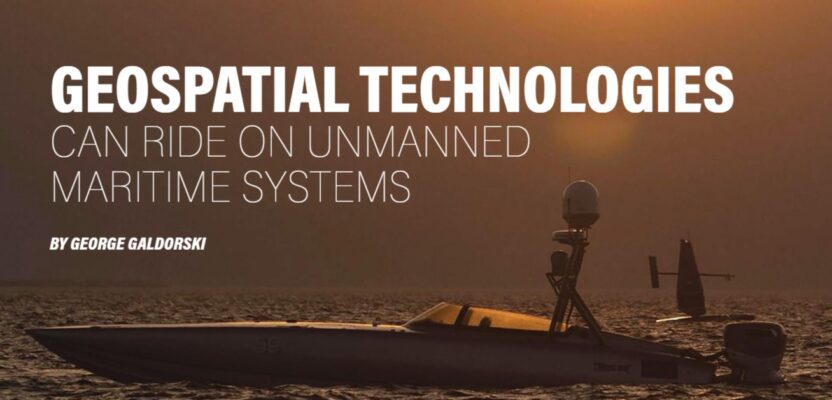By George Galdorski
For years, professionals in a wide range of fields—from oceanography to hydrography to ocean mapping, to deep sea mining and many others—have depended on geospatial technologies to help gather and analyze various aspects of the makeup of the oceans. Advances in this field have been well-documented in the pages of xyHt.
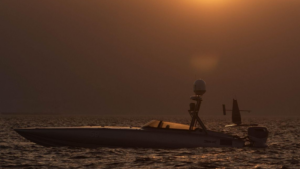
The Devil Ray (foreground) and Saildrone (background) operating in military exercises.
What is less well understood is the process and costs of collecting the data that is subsequently analyzed. For decades, this data was acquired by manned vessels. This was adequate for the task, but was also expensive, slow, tedious and underleveraged these multi-mission assets.
Recently, unmanned technologies have advanced to the point that they can be used for these efforts and either supplement or replace manned assets. Several types of unmanned assets can be used to collect data: unmanned air vehicles (UAVs), unmanned surface vehicles (USVs), and unmanned underwater vehicles (UUVs).
Of the three, unmanned surface vehicles are the most viable candidates for this task. They typically have longer dwell times than UAVs. They are more effective than UUVs because the physics of the ocean medium makes it challenging to control UUVs and extract the data they collect. Additionally, many types of USVs can be outfitted with solar panels, significantly increasing their time on station.
While turning over the task of collecting data from manned vessels is an attractive concept, there is always a challenge associated with adapting emerging technologies, and it is one that is quite intuitive: Will the new technology perform as predicted?
What readers of xyHt might not fully understand is why USVs have come to the fore as prime candidates for this endeavor. This opportunity exists for many reasons: world militaries have conducted a wide range of exercises, experiments, and demonstrations where USVs have been put in operators’ hands.
Unsurprisingly, these thousands of hours of testing have accelerated unmanned surface vehicle development and have resulted in an increasing number of these versatile and affordable USVs being available in the global marketplace. Therefore, the opportunity exists to harness them to do the work previously done only by manned vessels. Here is how we arrived at this serendipitous junction.
Military Initiatives to Advance the Development of Unmanned Surface Vehicles
Two decades of conflict in Iraq and Afghanistan accelerated the development of UAVs and unmanned ground systems (UGVs). More recently, the Department of the Navy has begun to provide increased support for USVs and UUVs and has established program guidance for many of these systems of importance to the Navy and Marine Corps.
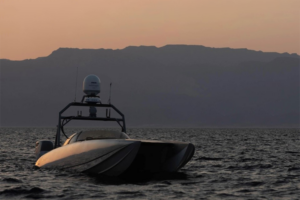
The Devil Ray uncrewed surface vehicle operates at any time of day regardless of weather conditions.
USVs have begun to take center stage and are now on an accelerated development path. Like their air and ground counterparts, these USVs are valued because of their ability to reduce the risk to human life in high threat areas, to deliver persistent surveillance over areas of interest, and to provide options that derive from the inherent advantages of unmanned technologies.
To be clear, the advantages of accelerating the development of unmanned surface vehicles have not been restricted to the United States. The U.S. Navy isn’t the only navy keenly interested in USVs. The past few years may be remembered as a high-water mark for the insertion of USVs into international exercises, experiments, and demonstrations that have spanned the globe.
A Global Span of USV Evaluation
Over the course of these events, unmanned maritime systems have performed an increasingly ambitious and complex series of missions, giving great confidence to those nations and navies who see them as an important part of their fleets. The highlights of these events show the keen interest of the navies of many nations in finding new missions for these systems.
International Maritime Exercise (IMX), held under the auspices of U.S. Naval Forces Central Command and Commander Task Force 59 (CTF-59) in the Arabian Gulf, focused on the integration of crewed and unmanned vessels and included operations with several regional partners.
Navies and coast guards involved in IMX worked to explore the capabilities of unmanned systems such as the Saildrone, the MARTAC MANTAS and Devil Ray, and many other USVs from participating nations. This is the first time this many nations participated in this type of event.
In the run up to International Maritime Exercise, the commander of U.S. Naval Forces Central Command/U.S. 5th Fleet, vice admiral Brad Cooper, noted: “The Navy has been working with manufacturers to test new technologies, including firms such as Saildrone and MARTAC under a contractor-owned, contractor-operated model.”
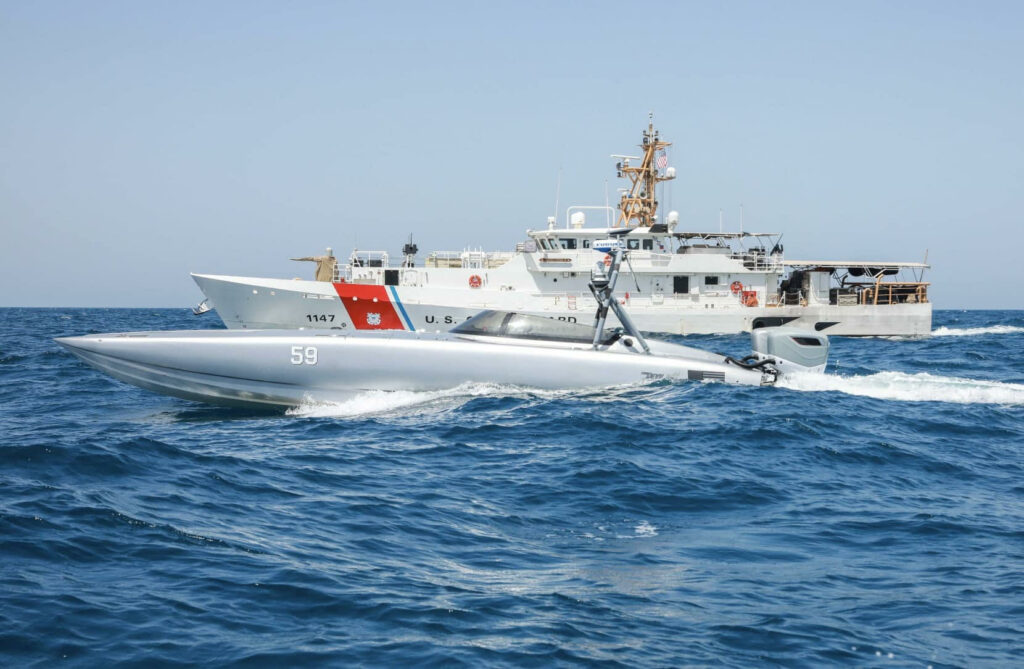
Maritime Tactical Systems’ uncrewed surface vehicle Devil Ray operated by the U.S. Coast Guard.
What is noteworthy about CTF-59 operations in the Arabian Gulf is the fact that IMX was not a “one-off.” Rather, crewed-unmanned integration operations in the Arabian Gulf continue. The U.S. Navy now has 20 USVs in or near the waters of the Arabian Gulf. Indeed, the United States and its allies want to ultimately have a force of 100 unmanned surface vessels patrolling waters from the Red Sea into the Arabian Gulf.
One U.S. USV company, MARTAC, was a primary participant in IMX. Their unmanned surface vehicles, MANTAS and Devil Ray, were mainstays of this exercise. Here is how one defense analyst, writing in Inside the Navy, captured the essence of MARTAC’s participation in this major exercise:
“MARTAC has a strong presence is 5th Fleet operating with Task Force 59, a Middle East-based task force working on the development of unmanned systems…Typical missions for MARTAC include intelligence, surveillance and reconnaissance, port and harbor security, and sensing capabilities, in addition to classified missions.”
In another international exercise focused on missions for unmanned maritime systems, the Australian Defence Force (ADF) hosted Exercise Autonomous Warrior (AW). Nations participating in this Royal Australian Navy-led exercise included Australia, New Zealand, the United Kingdom, and the United States and featured a total of 30 autonomous systems. The USVs that were part of this two-week exercise were the Saildrone, MANTAS, and Devil Ray featured in IMX, the Atlas Elektronik ARCIMS, the Elbit Systems Australia SEAGULL, and the Ocius Bluebottle.
Another event, the bi-annual Rim of the Pacific Exercise (the world’s largest international maritime exercise) was especially noteworthy as the U.S. Navy inserted four unmanned surface vehicles in this major international exercise. The Rim of the Pacific exercise gave the event’s 26 participating nations an opportunity to see these USVs in action.
One of the important lessons learned regarding the operations of unmanned surface vessels during RIMPAC was what was important to the sailors operating these four USVs. One official from the Navy’s program office for unmanned maritime systems noted that: “One of the biggest pieces of feedback we’re getting is that they’re [sailors operating these USVs during RIMPAC] talking about payloads, they’re talking about capabilities. They’re not talking about autonomy. They’re not worried that [the USV is] going to ever run into something.”
On the other side of the world, NATO exercises REPMUS and the follow-on Dynamic Messenger, provided an opportunity for NATO nations to evaluate unmanned systems and their ability to coordinate on, above, and under the sea. Led by Portugal and conducted near the Troia Peninsula, these exercises focused on the integration of 120 autonomous assets into a single network.
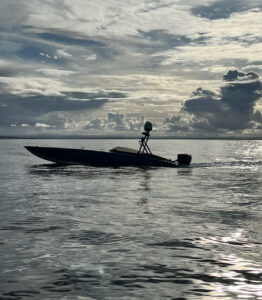
The Devil Ray uncrewed surface vehicle operates at any time of day regardless of weather conditions.
Later, the U.S. Navy-led exercise Digital Horizon, a three-week event in the Middle East, focused on employing artificial intelligence and 15 different unmanned systems (12 USVs and three UAVs), many of which were operated in the region for the first time. The exercise, meant to be a continuation of IMX but on a significantly larger scale, was hosted by Task Force 59, and built on the work done during IMX. Digital Horizon was the largest international unmanned exercise ever held.
Digital Horizon brought together new, emerging unmanned technologies and combined them with data analytics and artificial intelligence to enhance regional maritime security and strengthen deterrence. The exercise featured 17 companies that collectively brought 15 different types of unmanned systems, 10 of which operated with U.S. 5th Fleet for the first time. One of the objectives of Digital Horizon was to use unmanned maritime vehicles to conduct intelligence surveillance and reconnaissance missions, including identifying objects in the water and spotting suspicious behavior.
Leveraging Military Unmanned Surface Vehicle Evaluation for Civilian Applications
Looking ahead, world navies are keen to bring both commercial-off-the-shelf (COTS) unmanned surface vehicles, as well as other USVs in various stages of development, to exercises, experiments, and demonstrations. This will enable them to not only demonstrate their own capabilities, but to also learn best practices by observing the operations of unmanned surface vehicles of other nations.
As this occurs, it is highly likely that unmanned surface vehicle manufacturers will develop and field increasingly capable and affordable USVs. This will enable the many professional fields that depend on geospatial technologies to refine and upgrade their processes and procedures. The results will help accelerate improvements in this realm.
Capt. George Galdorisi is a career naval aviator and national security professional. His 30-year career culminated in 14 years of consecutive service as executive officer, commanding officer, commodore, and chief of staff. He enjoys writing, especially speculative fiction about the future of warfare. He is the author of 18 books, including four consecutive New York Times bestsellers. His latest book, published by the U.S. Naval Institute, is Algorithms of Armageddon: The Impact of Artificial Intelligence on Future Wars.

